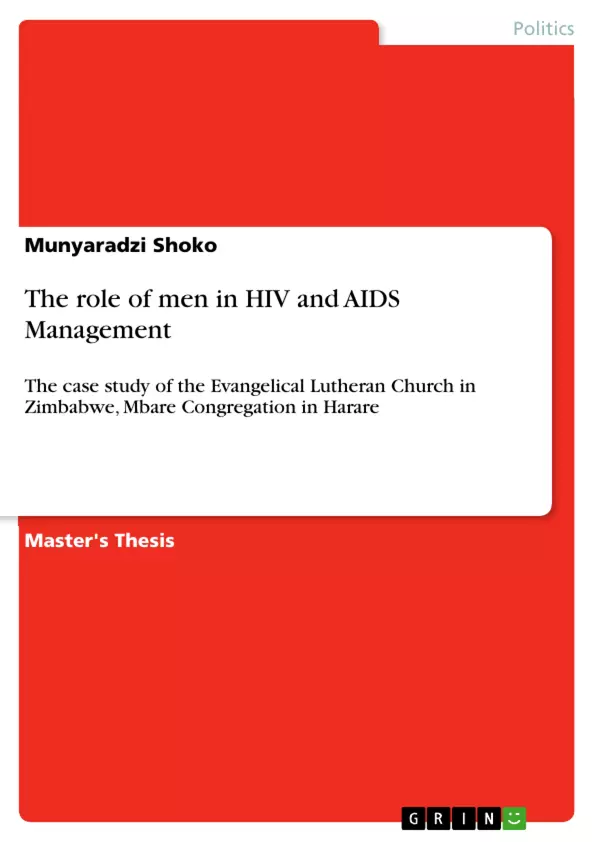
The role of men in HIV and AIDS Management
Masterarbeit, 2011
58 Seiten, Note: none
Leseprobe
Inhaltsverzeichnis (Table of Contents)
- Chapter 1
- 1.1 Introduction
- 1.2 Background of study and problem statement
- 1.3 Activities of churches in HIV/AIDS
- 1.4 Role of men in HIV/AIDS
- 1.5 Men's involvement in care and support
- 1.6 Research aim
- 1.7 Research objective
- 1.8 Hypothesis
- 1.9 Research questions
- Chapter 2
- 2.1 Literature review
- 2.2 National HIV/AIDS policy 1999 document
- 2.2.1 Multi-sectoral approach to HIV/AIDS and problems
- 2.2.2 Upholding of human rights
- 2.3 Lack of clear theology on HIV/AIDS
- 2.4 Lack of training in psychological counseling for pastors
- 2.5 Lack of focus in the provision of care
- 2.6 Lack of capacity in resources to allow for an alternate approach to care
- 2.7 The education gaps
- 2.8 Knowledge on sexuality
Zielsetzung und Themenschwerpunkte (Objectives and Key Themes)
The study aimed to assess the role of men in HIV and AIDS management within the Evangelical Lutheran Church in Zimbabwe, Harare, Mbare Congregation. Data was collected through questionnaires and analyzed to understand how the church can better engage its members in HIV and AIDS awareness. The research focuses on the need for training pastors on HIV and AIDS issues, as well as involving men in care and management of HIV and AIDS issues.
- Role of men in HIV and AIDS management in the Evangelical Lutheran Church in Zimbabwe
- Importance of religious institutions in promoting HIV and AIDS awareness
- Need for training pastors on HIV and AIDS issues
- Engagement of men in care and management of HIV and AIDS issues
- Impact of cultural and religious beliefs on HIV and AIDS prevention and management
Zusammenfassung der Kapitel (Chapter Summaries)
Chapter 1 introduces the study and its background, outlining the problem statement and the activities of churches in HIV and AIDS prevention. It also examines the role of men in HIV and AIDS and their involvement in care and support. The chapter then establishes the research aim, objective, hypothesis, and research questions.
Chapter 2 explores the literature review, focusing on the national HIV/AIDS policy of 1999. It examines the multi-sectoral approach to HIV and AIDS, the importance of upholding human rights, and the challenges faced in addressing HIV/AIDS issues within religious contexts. This chapter further highlights the lack of a clear theology on HIV and AIDS, the need for training pastors in psychological counseling, the limitations in providing care, and the capacity constraints in implementing alternative approaches. The chapter concludes by discussing the educational gaps and the need for better knowledge on sexuality.
Schlüsselwörter (Keywords)
HIV/AIDS, Evangelical Lutheran Church, Zimbabwe, Harare, Mbare Congregation, Men's Involvement, Church Engagement, Pastor Training, HIV and AIDS Awareness, Care and Management, Cultural Beliefs, Religious Beliefs.
Details
- Titel
- The role of men in HIV and AIDS Management
- Untertitel
- The case study of the Evangelical Lutheran Church in Zimbabwe, Mbare Congregation in Harare
- Veranstaltung
- Post Graduate Diploma in Sustainable Community Development
- Note
- none
- Autor
- Munyaradzi Shoko (Autor:in)
- Erscheinungsjahr
- 2011
- Seiten
- 58
- Katalognummer
- V182199
- ISBN (eBook)
- 9783656060079
- ISBN (Buch)
- 9783656060185
- Dateigröße
- 654 KB
- Sprache
- Englisch
- Anmerkungen
- The research paper has been marked and awarded a pass mark
- Schlagworte
- aids management evangelical lutheran church zimbabwe mbare congregation harare
- Produktsicherheit
- GRIN Publishing GmbH
- Preis (Ebook)
- US$ 20,99
- Preis (Book)
- US$ 29,99
- Arbeit zitieren
- Munyaradzi Shoko (Autor:in), 2011, The role of men in HIV and AIDS Management, München, Page::Imprint:: GRINVerlagOHG, https://www.diplomarbeiten24.de/document/182199
- Autor werden
- Ihre Optionen
- Vertriebskanäle
- Premium Services
- Autorenprofil
- Textarten und Formate
- Services für Verlage, Hochschulen, Unternehmen

- © GRIN Publishing GmbH.
- Alle Inhalte urheberrechtlich geschützt. Kopieren und verbreiten untersagt.
- info@grin.com
- AGB
- Open Publishing
Der GRIN Verlag hat sich seit 1998 auf die Veröffentlichung akademischer eBooks und Bücher spezialisiert. Der GRIN Verlag steht damit als erstes Unternehmen für User Generated Quality Content. Die Verlagsseiten GRIN.com, Hausarbeiten.de und Diplomarbeiten24 bieten für Hochschullehrer, Absolventen und Studenten die ideale Plattform, wissenschaftliche Texte wie Hausarbeiten, Referate, Bachelorarbeiten, Masterarbeiten, Diplomarbeiten, Dissertationen und wissenschaftliche Aufsätze einem breiten Publikum zu präsentieren.
Kostenfreie Veröffentlichung: Hausarbeit, Bachelorarbeit, Diplomarbeit, Dissertation, Masterarbeit, Interpretation oder Referat jetzt veröffentlichen!
- GRIN Verlag GmbH
-
- Nymphenburger Str. 86
- 80636
- Munich, Deutschland
- +49 89-550559-0
- +49 89-550559-10
- info@grin.com
-









